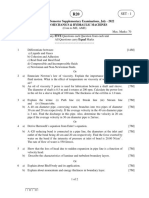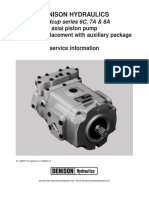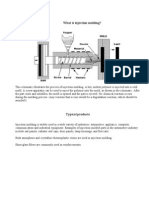Pigging Frequency
Pigging Frequency
Uploaded by
khalid ahmedCopyright:
Available Formats
Pigging Frequency
Pigging Frequency
Uploaded by
khalid ahmedOriginal Title
Copyright
Available Formats
Share this document
Did you find this document useful?
Is this content inappropriate?
Copyright:
Available Formats
Pigging Frequency
Pigging Frequency
Uploaded by
khalid ahmedCopyright:
Available Formats
See discussions, stats, and author profiles for this publication at: https://www.researchgate.
net/publication/262689808
Identifying Optimal Pigging Frequency for Oil Pipelines Subject to Non-Uniform
Wax Deposition Distribution
Conference Paper · September 2014
DOI: 10.1115/IPC2014-33064
CITATION READS
1 976
5 authors, including:
Wenda Wang Qiyu Huang
China National Petroleum Corporation China University of Petroleum
18 PUBLICATIONS 54 CITATIONS 50 PUBLICATIONS 213 CITATIONS
SEE PROFILE SEE PROFILE
Si Li
China University of Petroleum
10 PUBLICATIONS 32 CITATIONS
SEE PROFILE
Some of the authors of this publication are also working on these related projects:
Physical properties of wax deposits on the walls of crude pipelines View project
All content following this page was uploaded by Wenda Wang on 29 September 2014.
The user has requested enhancement of the downloaded file.
Proceedings of the 2014 10th International Pipeline Conference
IPC2014
September 29 - October 3, 2014, Calgary, Alberta, Canada
IPC2014-33064
IDENTIFYING OPTIMAL PIGGING FREQUENCY FOR OIL PIPELINES SUBJECT TO
NON-UNIFORM WAX DEPOSITION DISTRIBUTION
Wenda Wang Qiyu Huang*
National Engineering Laboratory for Pipeline National Engineering Laboratory for Pipeline
Safety/Beijing Key Laboratory of Urban Oil and Safety/Beijing Key Laboratory of Urban Oil and
Gas Distribution Technology Gas Distribution Technology
China University of Petroleum (Beijing) China University of Petroleum (Beijing)
Beijing 102249, China Beijing 102249, China
Email: wenda19870625@163.com Email: ppd@cup.edu.cn
Si Li Changhui Wang Xi Wang
National Engineering Laboratory National Engineering Laboratory National Engineering Laboratory
for Pipeline Safety/Beijing Key for Pipeline Safety/Beijing Key for Pipeline Safety/Beijing Key
Laboratory of Urban Oil and Gas Laboratory of Urban Oil and Gas Laboratory of Urban Oil and Gas
Distribution Technology Distribution Technology Distribution Technology
China University of Petroleum China University of Petroleum China University of Petroleum
(Beijing) (Beijing) (Beijing)
Beijing 102249, China Beijing 102249, China Beijing 102249, China
ABSTRACT precipitate from oil to form wax crystallites. The flocculation of
Wax deposition in oil pipelines causes reduced throughput precipitated wax crystallites in the vicinity of cold inner wall
and other associated problems. Periodical pigging program leads to the formation of gels with complex morphology. The
can effectively minimize the cost of wax deposition. This paper gels can grow rapidly and can evolve into much harder solid
shows a typical pigging case study for a field pipeline subject phase deposit [1, 2]. Wax deposition in pipelines can largely
to non-uniform wax deposition distribution by using a reduce the flow rate and can even cause a total flow blockage.
developed wax deposition model. The model prediction results Routine remediation has to be scheduled to remove the wax
prove that the wax is distributed in a short, localized deposits periodically. Mechanical, thermal and chemical
accumulation along the first half pipeline. The resultant techniques have been used for wax removal [3]. However,
pressure drop along the pipeline was examined to reveal the chemical treatments, such as wax solvents and dispersants, are
effects of non-uniform wax deposition distribution on the not practical in large export pipelines. It is because chemicals
pipeline production. In extreme case, the pressure drop of for wax removal must be concentrated and given sufficient
severe localized section increases by 50%, while this value contact time to become effective and it cannot be guaranteed to
between pump stations is merely 3%. A maximum wax thickness work in all cases. And it is inevitably costly to dose with several
of 2-4 mm is used as a criterion to determine an optimal hundred ppm of wax chemicals continuously. In addition, the
pigging frequency. The case study pipeline is recommended to thermal remediation of wax deposits is just effective over short
be pigged at a frequency of 10 to 15 days, using by-pass pigs. distances. In comparison with the above two treatments, the
traditional cleaning method using mechanical pigs is definitely
more effective and economical.
INTRODUCTION A fundamental understanding of the mechanisms of wax
A major problem in petroleum production is that of wax deposition is essential for the optimal design and
deposition within pipelines. At temperatures below the wax implementation of wax removal program including the pigging
appearance temperature (WAT), the paraffin molecules will frequency determination. In past decades, some classical
* Corresponding author. E-mail: ppd@cup.edu.cn; Tel: +86-10-89732203; Fax: +86-10-89732205.
1 Copyright © 2014 by ASME
mechanisms for wax deposition including but not limited to
molecular diffusion, shear dispersion, Brownian diffusion, and
gravitational settling were proposed to explain this specific
phenomenon [4]. Molecular diffusion of the dissolved wax is
generally accept to be the dominant mechanism responsible for
the wax deposition but the aging and sloughing effect of
previously deposited wax cannot be neglected [5, 6]. On this
basis, various mathematical models have been developed to
predict wax deposition [3]. Pressure drop variation is selected
preferentially to estimate the extent of wax deposition in field
for its easy availability. The pressure drop and fluid properties
are used to calculate the effective inside diameter of the
pipeline, and thus to determine the pigging frequency. However,
the hydraulic average deposit thickness determined from the
pressure drop method cannot reveal the actual condition,
especially for a short, localized wax accumulation [7]. It will Figure1. VISCOSITY-TEMPERATURE CHART
exaggerate the extent of average wax deposition for the entire
pipeline, meanwhile under-estimate the possible severe wax
deposition in some localized sections. Thus, if the pigging Measurement of rheological behavior
operation couldn’t be performed in time, potential wax plugging The gel point and viscosity were determined by the
or pig stuck would happen when de-waxing such a pipeline. Chinese Standard Test Method SY/T 0541-2009 and SY/T
This would lead to costly production losses. 0520-2008, respectively. Gel point in Chinese standard refers to
This paper discusses a typical pigging case for a pipeline the maximum temperature at which the test sample has just lost
subject to a short, localized wax accumulation. An applicable its flow ability under specified thermal and shear conditions.
wax deposition model for this pipeline was established based on The repeatability was good.
the specificity of the transported crude and pipeline profiles.
Then the wax thickness distribution and resultant pressure drop
behavior along this pipeline at different operating conditions Characterization of wax content and precipitation
were systematically studied. On this basis, the effect of non- At present, there are various thermodynamic models to
uniform wax deposition distribution on pipeline operation was calculate the wax precipitation amount. Most of these models
discussed further. A periodical wax removal program using by- are too complicated to be practical. DSC (Differential Scanning
pass pigs was recommended to maintain the pipeline in good Calorimeter) is widely considered as a practical method. A lot
condition. This paper also puts forward a pigging criterion used of tests have proved that wax precipitation amount determined
for case study. by DSC is consistent with that determined by most other regular
methods [8, 9].
A differential scanning calorimeter (TA2000/MDSC2910)
EXPERIMENTAL SECTION with 0.1W of the heat flux accuracy and 0.1 ℃ of the
temperature-controlled accuracy was used to characterize the
wax precipitation of oil sample. In a typical testing process, the
Crude Sample sample is heated to 80℃, held at this temperature for one
The crude sample was collected from the case study
minute and then cooled from 80 to -30℃ at a rate of 5℃/min.
pipeline to analyze the physical properties. Table 1 lists an
A thermal spectrum is recorded to show the relationship
overview of some properties of the crude sample. Figure 1 gives
between heat influx and programmed temperature. In the
the crude viscosity profiles as a function of temperature.
thermal spectrum, the temperature point that starts to deviate
from the baseline is the so-called WAT. The integral area
between the heat flow curve and the baseline from WAT to -
Table 1. PHYSICAL PROPERTIES OF THE CRUDE
SAMPLE 20℃ is used to calculate the average wax crystallization latent
heat. With the average heat of wax crystallization, the wax
content of the sample can be obtained [10, 11]. Figure 2 shows
the wax precipitation amount at different temperatures of the
Density at Wax
crude oil sample as determined by DSC. This provides basic
20℃ Gel point (℃) WAT (℃) content
data for the establishing of wax deposition model.
(kg/m3) (wt.%)
853.1 24 57 16.44
2 Copyright © 2014 by ASME
Table 2. SUMMARY OF FIELD PIPELINE PROFILES
Outlet
Soil
temperature of
temperature, ℃
station, ℃
Diameter, Length, Intermediate
mm km station
winter summer winter summer
323.9 320 No 27 33 80 65
Figure 2. WAX PRECIPITATION CHARACTERISTIC AT Prediction results and comparison
DIFFERENT COOLING TEMPERATURES The oil temperature simulation as described in Fig. 3
reveals that the overall heat transfer coefficient has no impact
on the arrival temperature for this pipeline when the outlet
RESULTS AND DISCUSSION temperature of station is fixed. In fact, the oil temperature and
soil temperature is pretty close in the second half pipeline. It is
because this pipeline is operated in a low flow rate regime and
Wax deposition model long-distance condition. It implies that there is no driving force
Huang [12] have developed a unified wax deposition for wax deposition in the second half pipeline. In other word,
model based on the flow loop test data from nine typical crude the wax deposition within pipeline is mainly accumulated in the
oils. He has also put forward the concepts of the effective wax first half pipeline.
precipitation (EWP) and effective deposition ratio (EDR) which Accurate prediction for wax buildup within pipeline can
occur in the thermal boundary layer within the pipe flow. There greatly assist the operator to make reasonable pigging program.
is a universal power-law relationship between EWP and EDR Both of the wax deposition rate and wax thickness distribution
for this unified model. Compared with other models, this profiles along this case study pipeline at different flow rates,
unified model could apply to many kinds of the crudes based on soil temperatures, overall heat transfer coefficients and
its basic physical properties with regression method. Thus an operation time were systematically predicted by using the
applicable mathematical model for predicting the wax developed model. Figures 4-8 show part of prediction results.
deposition in the case study pipeline was developed as These prediction results confirm the foregoing conclusion
described by following eqn. (1). Table 2 summarizes the case again. In addition, Figure 5 shows that wax deposition
study pipeline parameters which are necessary for wax occurring region expands and the maximum wax deposition rate
deposition prediction. decreases with the increasing flow rate when the soil
1 dC dT 0.6796 temperature and overall heat transfer coefficient are fixed.
W 302.8 w0.3476 ( )( ) (1)
dT dr
Where
W is the wax deposition rate in g/(m2·h).
w is the shear stress near pipe wall in Pa. The pipewall
shear stress of Newtonian fluid under turbulent flow can be
calculated by eqn. (2) [13].
8V
w 4.94 10 3 Re 0.75 (2)
d
μ is the viscosity of the crude oil in Pa·s, which can be
determined by interpolation for viscosity – temperature profile
shown in Fig. 1.
dC dT is the change of dissolved wax concentration
with regard to temperature near the pipe wall, (10-3/℃). This
Figure 3. OIL TEMPERATURE DISTRIBUTION ALONG
parameter can be measured by DSC (see Fig. 2).
THE PIPELINE WITH DIFFERENT K VALUES AT
dT dr is the radial temperature gradient near the pipe 1,000,000 t/a OF THROUGHPUT, 27℃ OF SOIL
wall in (℃/m). TEMPERATURE
3 Copyright © 2014 by ASME
OF THROUGHPUT AND 27℃ OF SOIL TEMPERATURE
2
WHEN K IS 2.0 W/(m ·℃)
Figure 4. WAX DEPOSITION RATE DISTRIBUTION
ALONG THE PIPELINE WITH DIFFERENT K VALUES
AT 1,000,000 t/a OF THROUGHPUT, 27℃ OF SOIL
TEMPERATURE Figure 7. WAX DEPOSITION THICKNESS
DISTRIBUTION ALONG THE PIPELINE WHEN SOIL
2
TEMPERATURE IS 27℃, K IS 2.0 W/(m ·℃) FOR 15
DAYS
Figure 5. WAX DEPOSITION RATE DISTRIBUTION
ALONG THE PIPELINE WITH DIFFERENT FLOW
RATES AT 27℃ OF SOIL TEMPERATURE WHEN K IS
2
2.0 W/(m ·℃) Figure 8. WAX DEPOSITION THICKNESS
DISTRIBUTION ALONG THE PIPELINE WHEN SOIL
2
TEMPERATURE IS 27℃, K IS 2.0 W/(m ·℃) FOR 10
DAYS
Pressure drop investigation
There are two impacts of wax deposition on the production
and operation of hot oil pipelines: 1) The increasing wax
deposits on pipe wall would decrease overall heat transfer
coefficient due to the insulation effect, and thus would reduce
heat loss along the pipeline and fuel costs; 2) The growing wax
deposition would increase the pumping power costs due to the
decreasing inner diameter of the pipeline. The total costs for
pipeline production include fuel costs, pumping power costs
and pigging expenses, etc. The economic pigging frequency can
Figure 6. WAX DEPOSITION THICKNESS be determined by calculating the minimum daily average costs.
DISTRIBUTION ALONG THE PIPELINE AT 1,000,000 t/a However, as clarified by Fig.3, the increasing wax thickness has
no impact on inlet temperature of station thereby the fuel costs
4 Copyright © 2014 by ASME
in this case study pipeline. However, the pumping power costs
increase with time because of wax buildup. So there is no
economic pigging frequency for this case study pipeline.
The increase of pressure drop per unit length along the
pipeline and the variation of total pressure drop between
stations with time were specially investigated and compared to
promote the understanding for non-uniform wax deposition
distribution effect. Partial results are presented in Figs. 9-10. In
the worst scenario, the pressure drop between stations only
increased by 3%, but in some severe localized sections with
more waxes, the pressure drop per unit length increased by
50%. In this case, the effect of wax deposition on the total
pressure drop is so weak that a pressure buildup cannot be
noticed. However, there are some localized sections with severe (a)
wax accumulation in this case study pipeline as indicated by the
large unit-length pressure drop. It may cause some hidden
dangers such as pig stuck or wax plugging if pigging is not
taken in time. These potential risks would pose a costly loss of
production.
(b)
Figure 10. THE EFFECT OF WAX DEPOSITION ON
PIPELINE PRESSURE DROP WHEN FLOW RATE IS
1,000,000 t/a OF THROUGHPUT, SOIL TEMPERATURE
2
IS 27℃ AND K IS 2.0 W/(m ·℃)
(a) Pigging strategies
It is advisable to keep the pigging risks to a minimum,
maximize the operating efficiency and reduce the costs of a
pipeline by developing a reasonable pigging program. A
maximum wax thickness of 2-4 mm is used as a pigging
criterion. This criterion incorporates the pipeline pigging risks
and production costs consideration. At present, the pipeline
throughput is 1,000,000 t/a. Thus a frequency for 10-15 days is
recommended for this case study pipeline based on the results in
Figs. 6-8. It is recognized that a by-pass jet is helpful in
dispersing the deposit in front of pigs and thus lowering the
stuck pig risk. So a pigging program with a by-pass jet is highly
recommended for de-waxing this case study pipeline.
(b)
Figure 9. THE EFFECT OF WAX DEPOSITION ON CONCLUSIONS
PIPELINE PRESSURE DROP WHEN FLOW RATE IS In this paper, the case study pipeline is subject to a short,
400,000 t/a OF THROUGHPUT, SOIL TEMPERATURE localized wax accumulation. The model prediction for wax
2
IS 27℃ AND K IS 2.4 W/(m ·℃) thickness in this case study pipeline and the effect of non-
uniform wax deposition distribution on pressure drop was
5 Copyright © 2014 by ASME
especially studied to pave a way for optimizing the pigging determine the wax porosity of mixtures precipitated from crude
frequency. A maximum wax thickness of 2-4 mm is used as a oils”. Energy Fuels, 25, pp. 1707-1713.
criterion to determine the optimal pigging frequency. Thus a [10] Huang, Q., Wang, J., Zhang, J., 2009. “Physical properties
periodical pigging (10 to 15 day cycle) together with a by-pass of wax deposits on the walls of crude pipelines”. Pet.Sci., 6, pp.
jet was recommended to maintain the case study pipeline in 64-68.
good condition. The additional inspirations for engineering [11] Li, H., Huang, Q., Zhang, F., Zhang, J., 2003.
practice are: “Determination of wax content in crude oil using Differential
(1) The traditional wax management for noticing pressure Scanning Calorimetry”. J. China Univ. Pet. Ed. Nat. Sci., 27(1),
buildup is not suitable for non-uniform wax distribution pp. 60-62.
pipeline. It is more reliable to monitor the actual wax buildup [12] Huang, Q., Li, Y., Zhang, J., 2008. “Unified wax
within the problem pipelines in real time than merely to notice deposition model”. Acta. Petrolei. Sinica. (in Chinese), 29(3),
the pressure buildup for wax management. pp. 459-462.
(2) A better pigging criterion should incorporate the [13] Yang X., 2006. Design and Administration of the Oil
pipeline pigging risks and production costs consideration Pipeline. 2nd ed. China University of Petroleum Press,
together. Dongying, Chap. 4, pp.156-157. (in Chinese)
ACKNOWLEDGMENTS
This work was supported by two grants from the National
Natural Science Foundation of China (No.51374224 and
No.51134006).
REFERENCES
[1] Singh, P., Venkatesan, R., Fogler, H., Nagarajan, N., 2000.
“Formation and aging incipient thin film wax-oil gels”. AIChE
J., 46, pp. 1059-1073.
[2] Singh, P., Venkatesen, R., Fogler, H., Nagarajan, N., 2001.
“Morphological evolution of thick wax deposits during aging”.
AIChE J., 47, pp. 6-18.
[3] Aiyejina, A., Chakrabarti, D., Pilgrim, A., Sastry, M., 2011.
“Wax formation in oil pipelines: A critical review”. Int. J.
Multiphas. Flow., 37, pp. 671–694.
[4] Azevedo, L., Teixeira, A., 2003. “A critical review of the
modeling of wax deposition mechanisms”. Pet.Sci.Technol., 21,
pp. 393-408.
[5] Tinsley, J., Prud’homme, R., Guo, X., Adamson, D.,
Callahan, S., Amin, D., Shao, S., Kriegel, R., Saini, R., 2007.
“Novel laboratory cell for fundamental studies of the effect of
polymer additives on wax deposition from model crude oils”.
Energy Fuels, 21, pp. 1301-1308.
[6] Hoffmann, R., Amundsen, L., 2010. “Single-phase wax
deposition experiments”. Energy Fuels, 24, pp. 1069-1080.
[7] Huang, Q., Miao, Q., Lu X., Fu L., 2008. “The impact of
non-identical wax deposition along the pipeline on the
calculation of wax-layer thickness”. Oil & Gas Storage and
Transportation(in Chinese), 27(3), pp. 24-26.
[8] Han, S., Huang, Z., Senra, M., Hoffmann, R., Fogler, H.,
2010. “Method to determine the wax solubility curve in crude
oil from centrifugation and high temperature gas
chromatography measurements”. Energy Fuels, 24, pp. 1753-
1761.
[9] Coto, B., Martos, C., Espada, J., Robustillo, M., Merino-
Garcia, D., Pena, J., 2011. “A new DSC-Based method to
6 Copyright © 2014 by ASME
View publication stats
You might also like
- Assignment 1Document4 pagesAssignment 1Ashish YadavNo ratings yet
- FIVDocument60 pagesFIVSaurabh Shukla100% (2)
- 1-s2.0-S2405656124000373-mainDocument10 pages1-s2.0-S2405656124000373-mainRedaNo ratings yet
- Pigging 2-3-2016AnirbidSircarandAnandGuptaDocument9 pagesPigging 2-3-2016AnirbidSircarandAnandGuptaAlaaNo ratings yet
- A Review On Casing While Drilling Technology For Oil and Gas Production With Well Control Model and Economical AnalysisDocument39 pagesA Review On Casing While Drilling Technology For Oil and Gas Production With Well Control Model and Economical AnalysisGeorgian-Răzvan CheșcaNo ratings yet
- Effect of Chevron-Shaped Wetting Patterns On Oil Film Thickness in Cylinder-On-Disc Contact Under Starved Lubrication or Limited Lubricant SupplyDocument39 pagesEffect of Chevron-Shaped Wetting Patterns On Oil Film Thickness in Cylinder-On-Disc Contact Under Starved Lubrication or Limited Lubricant Supplyzhy86222No ratings yet
- Spe 192741-MSDocument19 pagesSpe 192741-MSromerobernaNo ratings yet
- Ipc2022-86892 Pig Sweep Nanoparticles Transform PipelineDocument5 pagesIpc2022-86892 Pig Sweep Nanoparticles Transform PipelineOswaldo MontenegroNo ratings yet
- Iecr1 2016Document15 pagesIecr1 2016mali.abbas555110No ratings yet
- Drill 2015 32 4 747Document14 pagesDrill 2015 32 4 747sebastianNo ratings yet
- Aspen PlusR Simulation of A Coal Gasification ProcDocument6 pagesAspen PlusR Simulation of A Coal Gasification ProcI'm BoredNo ratings yet
- Biochemical Oxygen Demand (BOD) & Chemical Oxygen Demand (COD) Reduction in POMEDocument93 pagesBiochemical Oxygen Demand (BOD) & Chemical Oxygen Demand (COD) Reduction in POMEMan Djun100% (1)
- 1 s2.0 S2405656118301329 Main PDFDocument12 pages1 s2.0 S2405656118301329 Main PDFDheeraj VooraNo ratings yet
- Crude Oil DewaxingDocument9 pagesCrude Oil DewaxingEleonoraNo ratings yet
- Energies 15 04292 v3Document17 pagesEnergies 15 04292 v3FERNANDO PALOMINO CUYANo ratings yet
- Shokir Alqurishi PDFDocument15 pagesShokir Alqurishi PDF2591995No ratings yet
- Effect of Sample Incubation Period On MeasurementDocument12 pagesEffect of Sample Incubation Period On MeasurementabdiNo ratings yet
- Need of Flow Assurance For Crude Oil PropertiesDocument8 pagesNeed of Flow Assurance For Crude Oil Propertiesvande852001No ratings yet
- Spe 26604 MsDocument16 pagesSpe 26604 MsJesus D. Arrieta GarridoNo ratings yet
- Optimizing Pigging Frequency For Dewaxing of Crude Oil PipelinesDocument8 pagesOptimizing Pigging Frequency For Dewaxing of Crude Oil PipelinesAyauwu LovedayNo ratings yet
- An Experimental and Simulation Study of Wax Deposition in Hydrocarbon PipelineDocument15 pagesAn Experimental and Simulation Study of Wax Deposition in Hydrocarbon PipelineInggrialianthari Rezkhi TrinugrahandiniNo ratings yet
- Review PredictionofpointefficiencyDocument42 pagesReview PredictionofpointefficiencyTanvir ShawonNo ratings yet
- Acs Energyfuels 2c03625Document30 pagesAcs Energyfuels 2c03625Israel Arias GonzálezNo ratings yet
- Analysis of The Resin Transfer Molding RTM ProcessDocument7 pagesAnalysis of The Resin Transfer Molding RTM ProcesshafiNo ratings yet
- Petroleum Science and TechnologyDocument26 pagesPetroleum Science and TechnologyPranav KulkarniNo ratings yet
- Irjet V8i9303Document5 pagesIrjet V8i9303David SantosNo ratings yet
- Intelligent Well Technology-Dealing With Gas Coning Problems in Production WellsDocument16 pagesIntelligent Well Technology-Dealing With Gas Coning Problems in Production Wellsahmad hafidz mahendraNo ratings yet
- spe-220574-msDocument8 pagesspe-220574-msSegun AdebayoNo ratings yet
- SPE 181560 MS A Pigging Model For Wax Removal in Pipes 2016Document11 pagesSPE 181560 MS A Pigging Model For Wax Removal in Pipes 2016jainrakeshj4987No ratings yet
- Muther2020 Article AStudyOnDesigningAppropriateHyDocument12 pagesMuther2020 Article AStudyOnDesigningAppropriateHyBouthaina MihoubiNo ratings yet
- Crude Vacuum Tower Wash Bed Optimization: Chemical EngineeringDocument6 pagesCrude Vacuum Tower Wash Bed Optimization: Chemical EngineeringKamalesh KumarNo ratings yet
- An Overview of Pipeline Leak Detection TechnologiesDocument9 pagesAn Overview of Pipeline Leak Detection TechnologiesharmlesdragonNo ratings yet
- Comparative Study of Moisture Removal Techniques For Mineral-Based Insulation OilDocument6 pagesComparative Study of Moisture Removal Techniques For Mineral-Based Insulation OilDante FilhoNo ratings yet
- A Review On Casing While Drilling Technology For Oil and Gas Production With Well Control Model and Economical AnalysisDocument39 pagesA Review On Casing While Drilling Technology For Oil and Gas Production With Well Control Model and Economical Analysisgulistan.aliNo ratings yet
- Chapter 8 New - PEQ 303 - Dr. Adel Salem - Spring 2024Document21 pagesChapter 8 New - PEQ 303 - Dr. Adel Salem - Spring 2024amiegy440No ratings yet
- Flow Assessment of Powders in Pneumatic Conveying - A Bench Top A PDFDocument385 pagesFlow Assessment of Powders in Pneumatic Conveying - A Bench Top A PDFwijaya adidarma100% (1)
- Acs Energyfuels 6b01307Document10 pagesAcs Energyfuels 6b01307Dinesh JoshiNo ratings yet
- A Facile and Economical Configuration For Continuous Generation and Separation of Oil in Water EmulsionDocument10 pagesA Facile and Economical Configuration For Continuous Generation and Separation of Oil in Water EmulsionIbraheem SalaudeenNo ratings yet
- FinalReport MRP8712013Document75 pagesFinalReport MRP8712013Anonymous 3VNugnNo ratings yet
- Fouling in Crude Oil Preheat Trains: A Systematic Solution To An Old ProblemDocument15 pagesFouling in Crude Oil Preheat Trains: A Systematic Solution To An Old ProblemAtharva DatarNo ratings yet
- Wax Removal in Pipeline PDFDocument291 pagesWax Removal in Pipeline PDFKhwanas LuqmanNo ratings yet
- Review 2 - Distillation ColumnDocument9 pagesReview 2 - Distillation ColumnJay Sheth9No ratings yet
- Example of Viscometer Design and Fabrication Report-1Document6 pagesExample of Viscometer Design and Fabrication Report-1Candice ChitaNo ratings yet
- 2017-Slug Frequency Viscosity Oil Gas 2 Phase FlowDocument16 pages2017-Slug Frequency Viscosity Oil Gas 2 Phase FlowBeatriz Joo LeeNo ratings yet
- Iptc 21953 EaDocument9 pagesIptc 21953 EaAkis AliarNo ratings yet
- Ampp 2022 17826Document11 pagesAmpp 2022 17826LeoNo ratings yet
- IADC/SPE 87197 Reverse Circulation of Primary Cementing Jobs-Evaluation and Case HistoryDocument8 pagesIADC/SPE 87197 Reverse Circulation of Primary Cementing Jobs-Evaluation and Case Historyadvantage025No ratings yet
- Vacuum Pump DesignDocument7 pagesVacuum Pump DesignDiego JimenezNo ratings yet
- Cement CT BPDocument66 pagesCement CT BPJose Leonardo Materano PerozoNo ratings yet
- Treatment of Oily Wastewater by Fibrous Coalescer Process Stage Coalescer andDocument7 pagesTreatment of Oily Wastewater by Fibrous Coalescer Process Stage Coalescer andRamachandran PrashanthNo ratings yet
- Flow Assurance Simulation of Wax Deposition for RaDocument14 pagesFlow Assurance Simulation of Wax Deposition for RaAfamefuna StephenNo ratings yet
- Ballast Tank CoatingDocument22 pagesBallast Tank CoatingDiana Morales100% (1)
- Spe 189932 MsDocument10 pagesSpe 189932 MsRenzo LópezNo ratings yet
- A Heuristic Approach For Petrochemical Plant Layout Considering Steam Pipeline LengthDocument7 pagesA Heuristic Approach For Petrochemical Plant Layout Considering Steam Pipeline LengthTuesou MachereNo ratings yet
- Progress in Experimental Investigations On Evaporation 2 Characteristics of A Fuel DropletDocument49 pagesProgress in Experimental Investigations On Evaporation 2 Characteristics of A Fuel DropletOlamide50No ratings yet
- Experimental and Numerical Study of Vacuum Resin Infusion For Thin-Walled Composite PartsDocument27 pagesExperimental and Numerical Study of Vacuum Resin Infusion For Thin-Walled Composite PartsAfdol StoryNo ratings yet
- Coatings 11 01003Document15 pagesCoatings 11 01003mstfbrkydmrNo ratings yet
- Monobore CompletionDocument100 pagesMonobore CompletionHeiner Garcia0% (1)
- Journal of King Saud University - Engineering Sciences: Martins Obaseki, Paul T. ElijahDocument9 pagesJournal of King Saud University - Engineering Sciences: Martins Obaseki, Paul T. ElijahEdi Agurto CarrascoNo ratings yet
- Saddle Design DetailsDocument12 pagesSaddle Design Detailskhalid ahmedNo ratings yet
- Alignment SheetDocument1 pageAlignment Sheetkhalid ahmedNo ratings yet
- Material PropertiesDocument20 pagesMaterial Propertieskhalid ahmedNo ratings yet
- Scope of Work & MTO Compressor To H1Document4 pagesScope of Work & MTO Compressor To H1khalid ahmedNo ratings yet
- One Horsepower Is Equivalent To 33,000 Foot-Pounds Per MinuteDocument1 pageOne Horsepower Is Equivalent To 33,000 Foot-Pounds Per Minutekhalid ahmedNo ratings yet
- 010RCM IntroDocument39 pages010RCM Introkhalid ahmedNo ratings yet
- Overview of CFD Verification and ValidationDocument31 pagesOverview of CFD Verification and ValidationJohn ArmlessNo ratings yet
- Geberit Tablice MapressDocument175 pagesGeberit Tablice MapressIgor GligorijevicNo ratings yet
- Fluid Mechanics Hydraulic Machines July 2022Document2 pagesFluid Mechanics Hydraulic Machines July 2022530-M-004 AVINASH SAI GANGADANo ratings yet
- Differential Equations in The New Millennium: The Parachute ProblemDocument8 pagesDifferential Equations in The New Millennium: The Parachute ProblemIvan Ricardo Duquino CastiblancoNo ratings yet
- 95010-MS Water ShutoffDocument12 pages95010-MS Water Shutoffhade wantoNo ratings yet
- at DavisDocument40 pagesat DavisSsheshan PugazhendhiNo ratings yet
- PIPEPHASE Application BriefsDocument219 pagesPIPEPHASE Application Briefsarmando0212-1No ratings yet
- TDS - Total - Lubrilam S 40 L - 1as - 201412 - enDocument1 pageTDS - Total - Lubrilam S 40 L - 1as - 201412 - enVelibor KaranovicNo ratings yet
- Loctite 415™: Technical Data SheetDocument3 pagesLoctite 415™: Technical Data SheettheoNo ratings yet
- Top Drive: Recommended Lubricants and Hydraulic FluidDocument9 pagesTop Drive: Recommended Lubricants and Hydraulic FluidAlessandra FloresfarNo ratings yet
- Model Question Paper-CBCS Scheme: 18ME15/25 15ME751Document2 pagesModel Question Paper-CBCS Scheme: 18ME15/25 15ME751chandrashekar mNo ratings yet
- Fluid 9ed Solution Manual PDFDocument919 pagesFluid 9ed Solution Manual PDFDermz GayosoNo ratings yet
- Denison HydraulicsDocument48 pagesDenison HydraulicsPartagon Pow100% (2)
- App 1989 070370822Document10 pagesApp 1989 070370822fla0624No ratings yet
- 03MathematicalModellingOfChemicalProcesses - Doc 0Document12 pages03MathematicalModellingOfChemicalProcesses - Doc 0Anonymous P1iMibNo ratings yet
- Onset of Slugging in Horizontal Gas-Liquid Pipe Flow Bendiksen1992Document11 pagesOnset of Slugging in Horizontal Gas-Liquid Pipe Flow Bendiksen1992chunyuganlinNo ratings yet
- Science 9 Q3Document8 pagesScience 9 Q3keziaacubNo ratings yet
- Laporan PraktikumDocument19 pagesLaporan PraktikumMuhamad Choirul AzizNo ratings yet
- Lab AeroDocument6 pagesLab Aeroaty27062004No ratings yet
- Manual of Medical Physics PDFDocument48 pagesManual of Medical Physics PDFAli AlengineerNo ratings yet
- Viscosity Effects On Pump PerformanceDocument2 pagesViscosity Effects On Pump PerformanceADITYA_PATHAKNo ratings yet
- D 3185 SBRDocument6 pagesD 3185 SBRKhimeshNo ratings yet
- Numerical Simulation of Viscoelastic MaterialsDocument9 pagesNumerical Simulation of Viscoelastic MaterialsAllanNo ratings yet
- Fea QBDocument11 pagesFea QBPradeepNo ratings yet
- Tim1 KelasADocument5 pagesTim1 KelasARiatus SNo ratings yet
- Applied Well Test Interpretation 2013Document24 pagesApplied Well Test Interpretation 2013Vũ LêNo ratings yet
- Flow Past A Rotating CylinderDocument33 pagesFlow Past A Rotating CylinderBình Lê ĐứcNo ratings yet
- Injection MoldingDocument85 pagesInjection MoldingEzhil ArasuNo ratings yet































































































